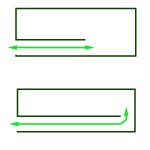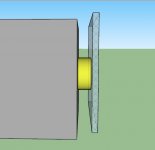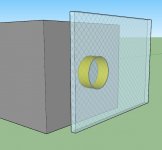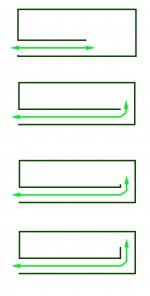Hello! This is my first post here so i apologise if im posting this in the wrong spot.
I have a pretty wild question, but i think it's definitely something worth looking into. A few days ago I was scrolling through a forum somewhere and saw someone mention how it's important to keep the distance between the bass-reflex port and the wall its against (if it is against one in the first place) a minimum of the port diameter apart. so, for example, if i have a 2" port, my port exit and the wall/floor should be atleast 2 inches from eachother.
This got me thinking... if you were to place a subwoofer so that its port exited the box super close to the floor, is it possible to use the floor to "extend" the length of your port, and effectively lower the tuning of the enclosure?
Not only would this greatly reduce the required length of the actual tube section of the port, it would make it possible to tune smaller enclosures lower while maintaining a fixed box volume.
ALSO - it would mean you could have 2 different tuning frequencies to chose from, and all you have to do to switch between them is rotate the cabinet on a different side so the port faces into/away from a wall.
Can i get any insight into whether or not this is an actual thing that could work, and how it could be calculated?
I have a pretty wild question, but i think it's definitely something worth looking into. A few days ago I was scrolling through a forum somewhere and saw someone mention how it's important to keep the distance between the bass-reflex port and the wall its against (if it is against one in the first place) a minimum of the port diameter apart. so, for example, if i have a 2" port, my port exit and the wall/floor should be atleast 2 inches from eachother.
This got me thinking... if you were to place a subwoofer so that its port exited the box super close to the floor, is it possible to use the floor to "extend" the length of your port, and effectively lower the tuning of the enclosure?
Not only would this greatly reduce the required length of the actual tube section of the port, it would make it possible to tune smaller enclosures lower while maintaining a fixed box volume.
ALSO - it would mean you could have 2 different tuning frequencies to chose from, and all you have to do to switch between them is rotate the cabinet on a different side so the port faces into/away from a wall.
Can i get any insight into whether or not this is an actual thing that could work, and how it could be calculated?
I'll take a crack at this; yes absolutely you can use walls to your advantage. The exact same effect happens inside the box when a port gets close to an internal wall. In the slot port example picture; when the port gets close to its own height away from the back wall, the effective length suddenly gets significantly longer, because the port effectively extends up the back wall as well. (The exact shape of that line is based on what is called the 'advanced centerline method' for calculating port lengths around folds, fwiw)
In my round port example (it's a little hard to see but it's supposed to be a round port in the middle of a gray box, firing against a solid wall of safety glass (so we can see through it)), the goal is to put it at a distance from the wall where the area of the (imaginary) yellow shape (a cylinder with no top or bottom) is equal to the cross-sectional area of the port. Any closer and you would be creating a tapered port; any further and you don't get the effect. This can be done inside the box as well.
That is about the most you can gain from a simple controlled wall offset.
To get a significantly longer effective port, you kind of have to build a slot port without one outside wall, and then plan to seal it pretty tightly against something. Which I believe is the challenge. And all you save is the material from one outside wall.
FWIW I've seen that idea mentioned - only to rule it out as cheating the rules of that particular game - in the single sheet tapped horn challenge thread, haha:
"BTW -- leaving out the bottom panel and saying "just sit it on the floor" is cheating....."
In my round port example (it's a little hard to see but it's supposed to be a round port in the middle of a gray box, firing against a solid wall of safety glass (so we can see through it)), the goal is to put it at a distance from the wall where the area of the (imaginary) yellow shape (a cylinder with no top or bottom) is equal to the cross-sectional area of the port. Any closer and you would be creating a tapered port; any further and you don't get the effect. This can be done inside the box as well.
That is about the most you can gain from a simple controlled wall offset.
To get a significantly longer effective port, you kind of have to build a slot port without one outside wall, and then plan to seal it pretty tightly against something. Which I believe is the challenge. And all you save is the material from one outside wall.
FWIW I've seen that idea mentioned - only to rule it out as cheating the rules of that particular game - in the single sheet tapped horn challenge thread, haha:
"BTW -- leaving out the bottom panel and saying "just sit it on the floor" is cheating....."
Attachments
Last edited:
Interesting how the effective port length can suddenly increase a bit as it approaches the back wall.
Actually... now that you mention it, i think that may be why the small subwoofer i made last week seems to be tuned ~5hz lower than expected. I was attempting to design the smallest possible sub enclosure tuned to 40hz using a tiny dayton audio TCP115-4 Woofer. I haven't measured it but it sounds like it doesn't start losing volume until around 35-36hz XD. I pushed the limits of how long i could make the port with the given box volume, and it ended up being roughly 1.5" short of the back wall, and the port ID is 1.6". Go figure...
Thanks for the detailed answer!
Actually... now that you mention it, i think that may be why the small subwoofer i made last week seems to be tuned ~5hz lower than expected. I was attempting to design the smallest possible sub enclosure tuned to 40hz using a tiny dayton audio TCP115-4 Woofer. I haven't measured it but it sounds like it doesn't start losing volume until around 35-36hz XD. I pushed the limits of how long i could make the port with the given box volume, and it ended up being roughly 1.5" short of the back wall, and the port ID is 1.6". Go figure...
LOL, well, I'm willing to cheat if it means MOAR BASS!"BTW -- leaving out the bottom panel and saying "just sit it on the floor" is cheating....."
Thanks for the detailed answer!
Interesting how the effective port length can suddenly increase a bit as it approaches the back wall.
I agree! I added another picture to clarify where the 'extra' comes from... It's just an L-shaped slot port where the short leg length is zero.
Actually... now that you mention it, i think that may be why the small subwoofer i made last week seems to be tuned ~5hz lower than expected.
Definitely could contribute! Also what the ends of the port look like (flares vs non, any other walls or braces nearby, etc).
For reference and further reading, I believe I got this info from the VBSS thread. I think someone in there even had an odd use case for adding a floating panel inside a box just for the ports to fire against (probably was using a commercial port kit with a fixed maximum length).



